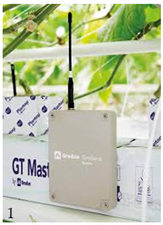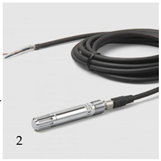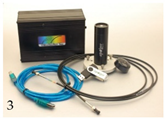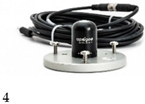
| Version | Summary | Created by | Modification | Content Size | Created at | Operation |
|---|---|---|---|---|---|---|
| 1 | Chelsea Rae Maier | -- | 2460 | 2022-10-12 02:52:38 | | | |
| 2 | Camila Xu | Meta information modification | 2460 | 2022-10-12 03:47:04 | | |
Video Upload Options
Protected cropping produces more food per land area than field-grown crops. Protected cropping includes low-tech polytunnels utilizing protective coverings, medium-tech facilities with some environmental control, and high-tech facilities such as fully automated glasshouses and indoor vertical farms. High crop productivity and quality are maintained by using environmental control systems and advanced precision phenotyping sensor technologies that were first developed for broadacre agricultural and can now be utilized for protected-cropping applications. The adoption of climate monitoring and control technologies and precision phenotyping methodologies in protected cropping is required for sustaining future food security and enhancing nutritional quality.
1. Introduction
2. Using Phenotyping to Advance the Protected-Cropping Industry
3. Environmental Monitoring Is a Prerequisite for Plant Phenotyping
3.1. Phenotypic Plasticity in Response to Environmental Parameters
3.2. Root-Zone Temperature, Moisture Content, and Electrical Conductivity
| Environmental Parameter | Impact on Crop | Sensor | Control Mechanism | Example |
|---|---|---|---|---|
| Electrical conductivity (EC) | High: Blossom-end rot, nutrient deficiency, and reduced yield. Low: Cell rupture. |
Slab or soil EC sensors (usually include temperature and moisture measurements) | Irrigation regimes, pH modification, and EC modification of stock solution |  |
| Root-zone moisture | High: Roots do not develop enough to support a full-grown producing plant. Low: Root die-off and plant dehydration. |
Soil-moisture probes or slab or soil EC sensors (usually include temperature and moisture measurements) | Properly timed irrigation and proper landscaping to prevent pooling (slope) | |
| Root-zone temperature | High: >25 °C, NH4 toxification, leading to cell death. Low: 3–11 °C, NH4 uptake stimulates plant growth. |
Soil-temperature and moisture probes that include EC measurements | Shade cloth, irrigation solution temperature, heating pad, and heating cables | |
| Air temperature | High: Leaf dehydration and earlier stomatal shutdown. Metabolic shutdown due to inability to dissipate heat. Low: Delayed blooming and stunted or slow growth. Large day–night temperature differentials impact fruit set. |
Dual air-temperature and relative-humidity probes | Pad and fan cooling, cold-coil fan cooling, shade cloth to reduce radiant heat, hot-water pipes, and hot air via external heat source |  |
| Relative humidity | High: Low stomatal conductance, reducing nutrient distribution to plant and fruit. Low: Early stomatal shutdown, resulting in reduced photosynthesis. |
Dual air-temperature and relative-humidity probes | Misting system, condensing system, and dehumidification | |
| Light quality | 280 nm: Reduces quantum yield and rate of photosynthesis. 315–400 nm: Promotes pigmentation and thickens plant leaves. 400–440 nm: Promotes vegetative growth. 640–660 nm: Vital for flowering. 740 nm: Increases photosynthesis [21]. |
Spectroradiometer or a combination of PAR and net radiometer | Colored shade cloth, fluorescent films, and light supplementation |  |
| Light quantity | High: Leaf dehydration, sunscald, photodamage, and lowered photosynthetic rates. Low: Stem elongation, lower photosynthetic rate, reduced yield, misshapen fruit, and reduced shelf life. |
PAR sensors | Shade cloth and light supplementation with light-emitting diodes |  |
3.3. Light Quality and Quantity
3.4. Temperature and Relative Humidity (RH)
3.5. Sensor Technology to Monitor Environmental Parameters
3.6. Environmental Monitoring Is a Prerequisite for Plant Phenotyping
-
Precise control over crop microclimate to maintain desired phenotypic expression across crop cycles;
-
Frequent phenotypic surveys of plants and fruit, throughout the cropping cycle and during post-harvest sorting, storage, and distribution.
References
- United Nations, Department of Economic and Social Affairs, Population Division. World Population Prospects Highlights, 2019 Revision Highlights, 2019 Revision; United Nations: New York, NY, USA, 2019; ISBN 978-92-1-148316-1.
- FAO; CIRAD. Fruit and Vegetables – Opportunities and challenges for small-scale sustainable farming; FAO: Rome, Italy; CIRAD: Montpelhièr, France, 2021.
- OECD; Food and Agriculture Organization of the United Nations. OECD-FAO Agricultural Outlook 2021–2030; OECD-FAO Agricultural Outlook; OECD: Montpelhièr, France, 2021; ISBN 978-92-64-43607-7.
- Shamshiri, R.; Kalantari, F.; Ting, K.C.; Thorp, K.R.; Hameed, I.A.; Weltzien, C.; Ahmad, D.; Shad, Z.M. Advances in Greenhouse Automation and Controlled Environment Agriculture: A Transition to Plant Factories and Urban Agriculture. Int. J. Agric. Biol. Eng. 2018, 11, 1–22.
- Rabbi, B.; Chen, Z.-H.; Sethuvenkatraman, S. Protected Cropping in Warm Climates: A Review of Humidity Control and Cooling Methods. Energies 2019, 12, 2737.
- Shi, X.; An, X.; Zhao, Q.; Liu, H.; Xia, L.; Sun, X.; Guo, Y. State-of-the-Art Internet of Things in Protected Agriculture. Sensors 2019, 19, 1833.
- Davis, J. Growing Protected Cropping in Australia to 2030; Protected Cropping Australia: Perth, Australia, 2020; p. 15.
- Achour, Y.; Ouammi, A.; Zejli, D. Technological Progresses in Modern Sustainable Greenhouses Cultivation as the Path towards Precision Agriculture. Renew. Sustain. Energy Rev. 2021, 147, 111251.
- Talebpour, B.; Türker, U.; Yegül, U. The Role of Precision Agriculture in the Promotion of Food Security. Int. J. Agric. Food Res. 2015, 4, 1–23.
- Tripodi, P.; Massa, D.; Venezia, A.; Cardi, T. Sensing Technologies for Precision Phenotyping in Vegetable Crops: Current Status and Future Challenges. Agronomy 2018, 8, 57.
- Barnes, A.P.; Soto, I.; Eory, V.; Beck, B.; Balafoutis, A.; Sánchez, B.; Vangeyte, J.; Fountas, S.; van der Wal, T.; Gómez-Barbero, M. Exploring the Adoption of Precision Agricultural Technologies: A Cross Regional Study of EU Farmers. Land Use Policy 2019, 80, 163–174.
- Humplík, J.F.; Lazár, D.; Husičková, A.; Spíchal, L. Automated Phenotyping of Plant Shoots Using Imaging Methods for Analysis of Plant Stress Responses—A Review. Plant Methods 2015, 11, 29.
- Mahlein, A.-K. Plant Disease Detection by Imaging Sensors—Parallels and Specific Demands for Precision Agriculture and Plant Phenotyping. Plant Dis. 2015, 100, 241–251.
- Yang, W.; Duan, L.; Chen, G.; Xiong, L.; Liu, Q. Plant Phenomics and High-Throughput Phenotyping: Accelerating Rice Functional Genomics Using Multidisciplinary Technologies. Curr. Opin. Plant Biol. 2013, 16, 180–187.
- Li, L.; Zhang, Q.; Huang, D. A Review of Imaging Techniques for Plant Phenotyping. Sensors 2014, 14, 20078–20111.
- Fiorani, F.; Schurr, U. Future Scenarios for Plant Phenotyping. Annu. Rev. Plant Biol. 2013, 64, 267–291.
- Riley, R.C.; Cavagnaro, T.R.; Brien, C.; Smith, F.A.; Smith, S.E.; Berger, B.; Garnett, T.; Stonor, R.; Schilling, R.K.; Chen, Z.-H.; et al. Resource Allocation to Growth or Luxury Consumption Drives Mycorrhizal Responses. Ecol. Lett. 2019, 22, 1757–1766.
- Ting, K.C.; Lin, T.; Davidson, P.C. Integrated Urban Controlled Environment Agriculture Systems. In LED Lighting for Urban Agriculture; Kozai, T., Fujiwara, K., Runkle, E.S., Eds.; Springer: Singapore, 2016; pp. 19–36. ISBN 978-981-10-1848-0.
- Adams, P.; Ho, L.C. The Susceptibility of Modern Tomato Cultivars to Blossom- End Rot in Relation to Salinity. J. Hortic. Sci. 1992, 67, 827–839.
- Cobden, J.; Grodan GroSens®. WC, TEMP and EC Meter. In AIS Greenworks; Available online: https://www.aisgreenworks.com.au/grodan-grosens-wcm/ (accessed on 13 September 2022).
- Van der Zwart, E. Understanding LED Wavelength for Horticulture. In Proceedings of the LED Event 2018, Den Bosch, The Netherlands, 21–28 November 2018.
- Gruda, N. Impact of Environmental Factors on Product Quality of Greenhouse Vegetables for Fresh Consumption. Crit. Rev. Plant Sci. 2005, 24, 227–247.
- Bakker, J.C.; Bot, G.P.A.; Challa, H.; van de Braak, N.J. Greenhouse Climate Control: An Integrated Approach; Wageningen Academic Publishers: Wageningen, The Netherlands, 1995; ISBN 978-90-74134-17-0.
- Gaudreau, L.; Charbonneau, J.; Vézina, L.-P.; Gosselin, A. Photoperiod and Photosynthetic Photon Flux Influence Growth and Quality of Greenhouse-Grown Lettuce. HortScience 1994, 29, 1285–1289.
- Eskins, K.; Warner, K.; Felker, F.C. Light Quality During Early Seedling Development Influences the Morphology and Bitter Taste Intensity of Mature Lettuce. (Lactuca Sativa) Leaves. J. Plant Physiol. 1996, 147, 709–713.
- What Is Sunlight? Available online: https://support.priva.com/hc/en-us/articles/360019407880-What-is-sunlight (accessed on 9 September 2022).
- Runkle, E.; Meng, Q. Far Red is the New Red; Inside Grower: West Chicago, WV, USA, 2017; Volume 2, pp. 26–30.
- Bhujel, A.; Basak, J.K.; Khan, F.; Arulmozhi, E.; Jaihuni, M.; Sihalath, T.; Lee, D.; Park, J.; Kim, H.T. Sensor Systems for Greenhouse Microclimate Monitoring and Control: A Review. J. Biosyst. Eng. 2020, 341–361.
- Ali, H. Impact of Preharvest Relative Air Humidity and Postharvest Modified Atmosphere Packaging on Cucumber Fruit Quality. Master’s Thesis, Norwegian University of Life Sciences, Ås, Norway, 2017.
- Shamshiri, R.R.; Jones, J.W.; Thorp, K.R.; Ahmad, D.; Man, H.C.; Taheri, S. Review of Optimum Temperature, Humidity, and Vapour Pressure Deficit for Microclimate Evaluation and Control in Greenhouse Cultivation of Tomato: A Review. Int. Agrophysics 2018, 32, 287–302.
- Teitel, M.; Atias, M.; Barak, M. Gradients of Temperature, Humidity and CO2 along a Fan-Ventilated Greenhouse. Biosyst. Eng. 2010, 106, 166–174.
- López, A.; Valera, D.L.; Molina-Aiz, F.D.; Peña, A. Sonic Anemometry to Evaluate Airflow Characteristics and Temperature Distribution in Empty Mediterranean Greenhouses Equipped with Pad–Fan and Fog Systems. Biosyst. Eng. 2012, 113, 334–350.
- Pieruschka, R.; Schurr, U. Plant Phenotyping: Past, Present, and Future. Available online: https://spj.sciencemag.org/plantphenomics/2019/7507131/ (accessed on 27 April 2020).
- Solanke, A.U.; Kumar, P.A. Phenotyping of Tomatoes. In Phenotyping for Plant Breeding: Applications of Phenotyping Methods for Crop Improvement; Panguluri, S.K., Kumar, A.A., Eds.; Springer: New York, NY, USA, 2013; pp. 169–204. ISBN 978-1-4614-8320-5.




